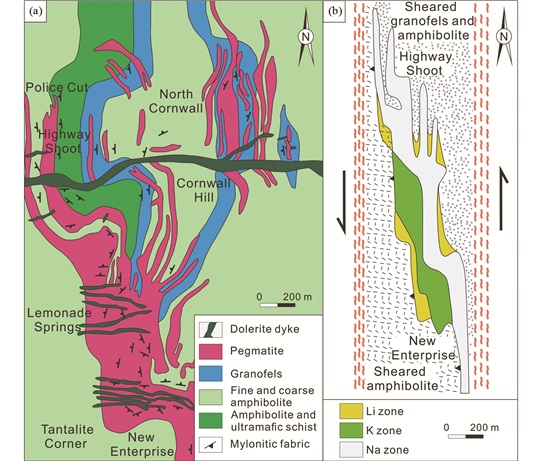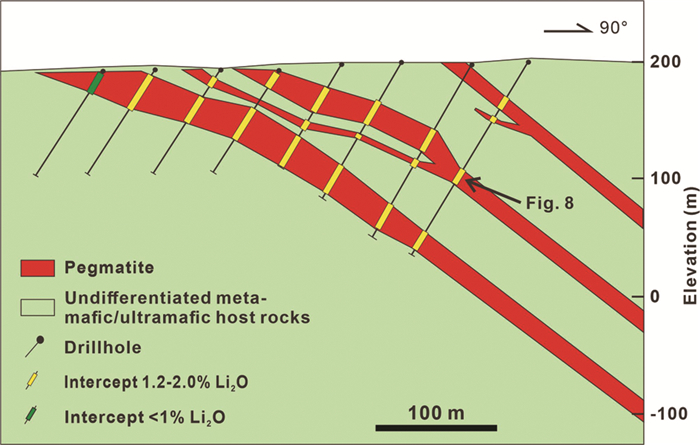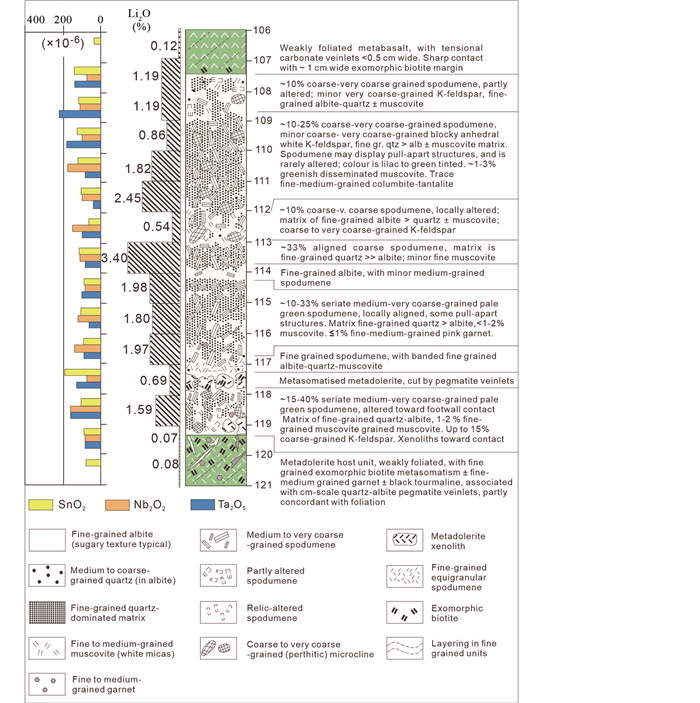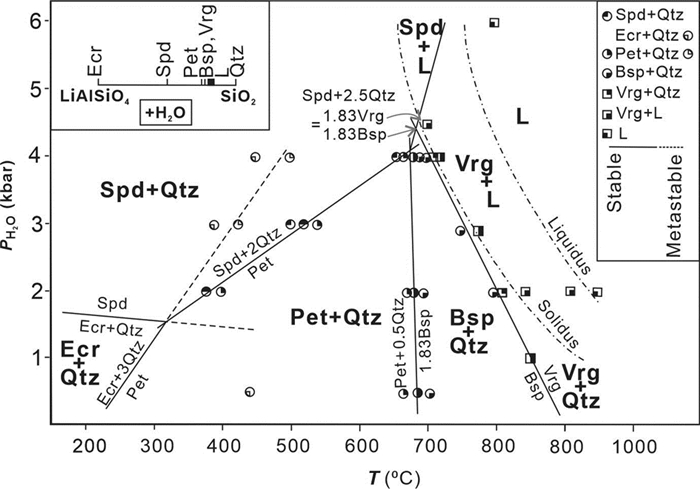2. Asgard Metals Pty Ltd, WA 6018, Australia;
3. Insight Geology Pty Ltd, VIC 3178, Australia
2. 阿斯加德金属有限公司,珀斯 6018;
3. 洞见地质有限公司,墨尔本 3178
As long-lived production of lithium from historic mines and production of other critical elements from Lithium-Cesium-Tantalum (LCT) pegmatites has slowed or ceased, exploration programs have been accelerated to meet increasing demand in this expanding world of technical innovation (Dessemond et al., 2019; Xiong et al., 2020). Many of the world's largest lithium pegmatite deposits have only been discovered in the past few years and there has been limited published research in scientific journals. Instead, the information is commonly restricted to data on company websites which emphasize exploration success and resource estimates at the expense of geological information on the pegmatites, and particularly on the nature of the host rocks. However, it has become clear that, except in exceptional cases, spodumene (LiAlSi2O6, Fig. 1) is the dominant economic lithium mineral, despite the abundance of other lithium minerals (Table 1).

|
Figure 1 Spodumene crystals (a) triphane from Nuristan, Laghman Province, Afghanistan; (b) kunzite from Mawi pegmatite, Nuristan, Afghanistan. Photos from Arkenstone: www.irocks.com. Permission sought |
|
|
Table 1 Variety of lithium-bearing minerals commonly found in natural rocks, particularly pegmatites and sediment-hosted deposits |
In this short preliminary paper, the reason for the predominance of spodumene in major to giant lithium pegmatites is sought and a robust model developed to explain repetitive critical parameters of the pegmatites and their host environment while realizing that not all critical data are available for the newly discovered deposits and total resources are difficult to assess for historical deposits with significant past production. Many of the references used are quite old because this was when fundamental research on the nature and zoning of the pegmatites was carried out. Apart from the references listed in Table 2, a literature search reveals that most modern references concentrate on specific aspects of lithium pegmatites and do not provide a holistic interpretation. For example, the mineralogy and/or mineral chemistry of associated minerals in spodumene pegmatites are described by Badanina et al. (2015), Feng et al. (2019), and Maneta and Baker (2019). Knoll et al. (2018) and Fei et al. (2020) discuss the petrogenesis and geochronology of spodumene pegmatites, and Barros and Menuge (2016) and Liu et al. (2020) discuss the genetic relationships between spodumene pegmatites and adjacent granite intrusions. Wilde et al. (2021) describe a new potentially giant lithium pegmatite province in Mali, and Steiner (2019) reviews the pegmatite literature and sets out pragmatic lithium exploration guides. However, none of these papers with the exception of a description of cristobalite from the Jiajika pegmatite, deal with known giant lithium-cesium-tantalum pegmatites, the subject of this paper.
|
|
Table 2 Overview of global major to giant lithium-bearing pegmatites for which there is adequate information on tonnage and grade, and on both pegmatites and host rocks |
As noted above, it is not possible to prepare a list of lithium-bearing pegmatite deposits in terms of a consistent set of characteristics for the multitude of global LCT pegmatite deposits compiled by Bradley et al. (2017). Instead, a more restricted list of many of the largest deposits is provided in Table 2, using the proviso that the deposit is economically significant and has a known resource and, where possible, there is confirmation of the principal lithium phase, and information on the attitude of the pegmatites and nature of the host rocks, particularly their metamorphic grade. To achieve this, mining company websites have been used as a source of information because, as discussed above, many of the newly discovered deposits have no scientific data of research quality. However, as the parameters sought are relatively basic, it is considered that Table 2 is reliable. The global occurrence of these pegmatites is shown in Fig. 2. There is some emphasis on Australia because of a 2017 publication that summarizes deposit data.

|
Figure 2 Map of the world showing location of the well-documented major lithium-bearing pegmatites listed in Table 2 (adapted after Bradley et al. 2017) |
Although Černý (1991, 1992) pointed out that many LCT and other pegmatites appeared to have been emplaced syn-tectonically, this appears to have been downplayed in many subsequent papers with most diagrammatic figures showing planar, near-vertical zoned pegmatites in the roof zones of granite plutons (Bradley et al., 2017).
Several independent lines of evidence suggest that the large to world-class spodumene pegmatites are syn-tectonic and syn-metamorphic bodies. Importantly, they are very rarely planar, more commonly having complex shapes in plan (Fig. 3a). They may also have extensive syn-metamorphic metasomatic alteration zones around them (Morgan and London, 1987). In rare cases, a syn-deformational model has been erected to explain both the complex shape and complex zoning of the pegmatites such as the giant Greenbushes pegmatite from the Yilgarn Block of Western Australia (Partington, 1990, 2017; Fig. 3b). Another good example of a giant pegmatite with a complex syn-deformational geometry is the Pilgangoora pegmatite from the Pilbara Block of Western Australia (Sweetapple et al., 2017; Fig. 4). Most of the economically important lithium pegmatites (Table 2) also have gentle dips or are sub-horizontal, as shown for the Pilgangoora pegmatite (Fig. 5) and the giant Kenticha pegmatite of Ethiopia (Küster et al., 2009; Fig. 6). This is entirely consistent with their emplacement in flat-lying dilation zones in a compressional to transpressional stress field in which the minimum principal stress (sigma 3) was subvertical. An analogy can be made to flat-lying extensional or 'ladder' veins in late-tectonic orogenic gold deposits (Robert and Paulsen, 2001). The gentle dip of the pegmatites is also critical for most efficient open-cut mining.

|
Figure 3 Geological map and structural model of Greenbushes lithium-bearing pegmatite (adapted after Partington, 2017) (a) map of giant Greenbushes lithium-bearing pegmatite, Western Australia, showing complex shape in amphibolite host rocks; (b) schematic structural model to explain complex zonation of the Greenbushes pegmatite during syn-metamorphic shearing |

|
Figure 4 Simplified geological map of the complex, syn-deformational geometries of the giant Pilgangoora lithium-tin-niobium-tantalum pegmatite swarm (after Sweetapple et al. 2017) Dashed line shows cross section of Fig. 5 in this map |

|
Figure 5 Schematic cross section based on diamond drill holes of the Pilgangoora pegmatites showing their gentle dip and consistent lithium grades (adapted after Sweetapple et al., 2017) |

|
Figure 6 Geological and mineralogical characteristics of Kenticha pegmatite, Ethiopia (after Tadesse and Zerihun, 1996; Küster et al., 2009) (a) cross section through the Kenticha pegmatite deposit, Ethiopia, highlighting, the flat dip, non-planar shape (complex in plain view), and strong vertical mineralogical zonation; (b) field photograph showing the flat-lying Kenticha pegmatite; (c) subvertical coarse grained spodumene crystals in the Kenticha pegmatite |
Pegmatites are typically emplaced at 500~600℃ and may cool rapidly if intruded into cold wall rocks, although Simmons and Webber (2008) demonstrated that the presence of fluxes and volatiles in pegmatite melts may suppress crystallization temperatures as low as 350℃. However, if emplaced broadly syn-tectonically and syn-metamorphically at upper greenschist to amphibolite facies (Table 2), at >500℃, the wall rocks would be at a similar temperature to the pegmatite fluid-rich melt for a significant time. This would slow cooling of even flux- and volatile-rich melts, and thus enhance differentiation and local enrichment of incompatible elements, and promote the formation of giant crystals, although these may also crystallize in post-metamorphic pegmatites (Simmons and Webber, 2008). The sub-horizontal form of the pegmatite bodies would also promote increased efficiency of vertical differentiation of pegmatite melts, with the formation of sub-vertical large to giant crystals (Fig. 6c). The inferred sub-horizontal dilation zones into which pegmatite melts were emplaced would also enhance the opportunity for multiple volatile-rich melt influxes with consequent both increase in thickness and critical element enrichment in the resultant pegmatite body (Fig. 7). Some authors have inferred such development of multiple melt pulses to explain complexities in pegmatite formation (Nabelek et al., 2010; Anderson et al., 2013). They would also help explain the ubiquitous occurrence of lithium grades of 0.54% to 3.40 % Li2O related to spodumene throughout the entire thickness of some flat-lying pegmatites at Pilgangoora in Western Australia (Sweetapple et al., 2017; Fig. 8).

|
Figure 7 Schematic representation of sub-horizontal pegmatite melt emplaced into flat dilation zone in amphibolite host rocks due to vertical sigma 3 (a) initial melt pulse with differentiation of upper lithium zone; (b) second melt emplaced during further dilation with differentiation of second lithium zone; (c) third pulse of melt to produce the final geometry of the pegmatite with a thick upper lithium zone |

|
Figure 8 Detailed graphic log of intercept at 106~121m in diamond drill hole PLS197M showing remarkable concentrations of Li, Sn, Nb, and Ta over the entire width of the pegmatite (after Sweetapple et al., 2017) |
There are few modern thermodynamic data relating to the stability of lithium silicate minerals. However, based on available experimental data (Stewart, 1978; London, 1984; Chakoumakos and Lumpkin, 1990), the higher pressures of the upper-greenschist to amphibolite facies environments (>2.5kbar) would favor spodumene formation at likely crystallization temperatures of 500℃ to 300℃, thus prolonging crystallization of flux- and volatile-rich melts and favoring the formation of giant crystals (Fig. 9). At lower pressures (< 2.0kbar) in the greenschist facies, petalite would form at high temperatures, making giant crystals less common. Other lithium silicates form at lower temperatures, explaining their absence in most economic lithium pegmatites.

|
Figure 9 Experimental P-T phase diagram for the bulk system 20 eucryptite 80 quartz (mol/mol) in the system LiAlSiO4-SiO2-H2O, showing stability field of spodumene (adapted after London, 1984: figure 1, with experimental conditions shown) Abbreviations: Bsp-β-spodumene; Ecr-eucryptite; Pet-petalite; Qtz-quartz; Spd-spodumene; Vrg-virgilite |
The anomalous abundance of the economic spodumene-bearing pegmatites in Archean greenstone belts is probably related to a combination of higher heat flow due to mantle plume activity and preservation of environments at the required crustal level due to the long-term stability of Archean cratons with anomalously thick lithosphere (Groves et al., 2005, and references therein).
6 ConclusionsLargely Archean, economic LCT pegmatites throughout the world are normally sub-horizontal to gently dipping, in contrast to many near-vertical pegmatite-swarms. They were emplaced during regional compression or transpression and regional metamorphism and, as a result, are hosted in amphibolite-facies wallrocks, have complex geometries with flat dips, are strongly mineralogically and geochemically zoned, and have metasomatic reaction zones against their wallrocks. Their flat dips suggest emplacement in dilation zones with minimum principal stress, sigma 3, sub-vertical, which would favor multiple pulses of lithium-rich melt. These syn-metamorphic conditions would have allowed greater time for vertical differentiation of flux- and volatile-rich pegmatitic melts during prolonged cooling, and importantly, expand the opportunity for large crystals of spodumene to crystallize within the critical P-T window of regional metamorphism. These critical parameters can be used to assess the potential of lithium-cesium-tantalum pegmatites to become giant economic deposits through exploration.
Acknowledgements We sincerely thank Deng Jun, Yang Liqiang, Wang Qingfei, Zu Bo and Xiong Yiqu for the opportunity to interact with them, and Shen Guanwen, Yu Tianwei, Li Jia and Wang Haoshuai for their help with the first draft of the figures.
Anderson MO, Lentz DR, McFarlane CRM, Falck H. 2013. A geological, geochemical and textural study of an LCT pegmatite: Implications for the magmatic versus metasomatic origin of Nb-Ta mineralization in the Moose Ⅱ pegmatite, Northwest Territories, Canada[J]. Journal of Geosciences, 58(4): 299-320. |
Badanina EV, Sitnikova MA, Gordienko VV, Melcher F, Gäbler HE, Lodziak J, Syritso LF. 2015. Mineral chemistry of columbite-tantalite from spodumene pegmatites of Kolmozero, Kola Peninsula (Russia)[J]. Ore Geology Reviews, 64: 720-735. DOI:10.1016/j.oregeorev.2014.05.009 |
Barros R, Menuge JF. 2016. The origin of spodumene pegmatites associated with the Leinster granite in southeast Ireland[J]. The Canadian Mineralogist, 54(4): 847-862. DOI:10.3749/canmin.1600027 |
Bradley DC, McCauley AD and Stillings LS. 2017. Mineral-deposit model for lithium-cesium-tantalum pegmatites. Reston: U.S. Geological Survey
|
Černý P. 1991. Rare-element granitic pegmatites. Part Ⅱ: Regional to global environments and petrogenesis[J]. Geoscience Canada, 18(1): 68-81. |
Černý P. 1992. Geochemical and petrogenetic features of mineralization in rare-element granitic pegmatites in the light of current research[J]. Applied Geochemistry, 7(5): 393-416. DOI:10.1016/0883-2927(92)90002-K |
Chakoumakos BC, Lumpkin GR. 1990. Pressure-temperature constraints on the crystallization of the Harding pegmatite, Taos County, New Mexico[J]. The Canadian Mineralogist, 28(2): 287-298. |
Dessemond C, Lajoie-Leroux F, Soucy G, Laroche N, Magnan JF. 2019. Spodumene: The lithium market, resources and processes[J]. Minerals, 9(6): 334. DOI:10.3390/min9060334 |
Fei GC, Menuge JF, Li YQ, Yang JY, Deng Y, Chen CS, Yang YF, Yang Z, Qin LY, Zheng L, Tang WC. 2020. Petrogenesis of the Lijiagou spodumene pegmatites in Songpan-Garze Fold Belt, West Sichuan, China: Evidence from geochemistry, zircon, cassiterite and coltan U-Pb geochronology and Hf isotopic compositions[J]. Lithos, 364-365: 105555. DOI:10.1016/j.lithos.2020.105555 |
Feng YG, Liang T, Yang XQ, Zhang Z, Wang YQ. 2019. Chemical evolution of Nb-Ta oxides and cassiterite in phosphorus-rich albite-spodumene pegmatites in the Kangxiwa-Dahongliutan pegmatite field, Western Kunlun Orogen, China[J]. Minerals, 9(3): 166. DOI:10.3390/min9030166 |
Groves DI, Vielreicher RM, Goldfarb RJ and Condie KC. 2005. Controls on the heterogeneous distribution of mineral deposits through time. In: McDonald I, Boyce AJ, Butler IB, Herrington RJ and Polya DA (eds.). Mineral Deposits and Earth Evolution. Geological Society, London, Special Publications, 248(1): 71-101
|
Huang T, Fu XF, Ge LQ, Zou FG, Hao XF, Yang R, Xiao RQ, Fan JB. 2020. The genesis of giant lithium pegmatite veins in Jiajika, Sichuan, China: Insights from geophysical, geochemical as well as structural geology approach[J]. Ore Geology Reviews, 124: 103557. DOI:10.1016/j.oregeorev.2020.103557 |
Knoll T, Schuster R, Huet B, Mali H, Onuk P, Horschinegg M, Ertl A, Giester G. 2018. Spodumene pegmatites and related leucogranites from the Austroalpine Unit (eastern Alps, central Europe): Field relations, petrography, geochemistry, and geochronology[J]. The Canadian Mineralogist, 56(4): 489-528. DOI:10.3749/canmin.1700092 |
Küster D, Romer RL, Tolessa D, Zerihun D, Bheemalingeswara K, Melcher F, Oberthur T. 2009. The Kenticha rare-element pegmatite, Ethiopia: Internal differentiation, U-Pb age and Ta mineralization[J]. Mineralium Deposita, 44(7): 723-750. DOI:10.1007/s00126-009-0240-8 |
Liu C, Wang RC, Wu FY, Xie L, Liu XC, Li XK, Yang L, Li XJ. 2020. Spodumene pegmatites from the Pusila pluton in the Higher Himalaya, South Tibet: Lithium mineralization in a highly fractionated leucogranite batholith[J]. Lithos, 358. |
London D. 1984. Experimental phase equilibria in the system LiAlSiO4-SiO2-H2O: A petrogenetic grid for lithium-rich pegmatites[J]. American Mineralogist, 69(11-12): 995-1004. |
Maneta V, Baker DR. 2019. The potential of lithium in alkali feldspars, quartz, and muscovite as a geochemical indicator in the exploration for lithium-rich granitic pegmatites: A case study from the spodumene-rich Moblan pegmatite, Quebec, Canada[J]. Journal of Geochemical Exploration, 205: 106336. DOI:10.1016/j.gexplo.2019.106336 |
Morgan GB, London D. 1987. Alteration of amphibolitic wallrocks around the Tanco rare-element pegmatite, Bernic Lake, Manitoba[J]. American Mineralogist, 72(11-12): 1097-1121. |
Morozova LN. 2018. Lithium Kolmozero deposit of rare metal pegmatites: New data on rare element composition (Kola Peninsula)[J]. Lithosphere (Russia), 18(1): 82-98. DOI:10.24930/1681-9004-2018-18-1-082-098 |
Nabelek PI, Whittington AG, Sirbescu MLC. 2010. The role of H2O in rapid emplacement and crystallization of granite pegmatites: Resolving the paradox of large crystals in highly undercooled melts[J]. Contributions to Mineralogy and Petrology, 160(3): 313-325. DOI:10.1007/s00410-009-0479-1 |
Partington GA. 1990. Environment and structural controls on the intrusion of the giant rare metal Greenbushes pegmatite, Western Australia[J]. Economic Geology, 85(3): 437-456. DOI:10.2113/gsecongeo.85.3.437 |
Partington GA. 2017. Greenbushes tin, tantalum and lithium deposit. In: Phillips N (ed.). Australian Ore Deposits. Australasian Institute of Mining and Metallurgy Melbourne Monograph, 32: 153-157
|
Porter TM. 2017. Mount Cattlin lithium-tantalum deposit. In: Phillips N (ed.). Australian Ore Deposits. Australasian Institute of Mining and Metallurgy Melbourne Monograph, 32: 857-858
|
Robert F and Paulsen KH. 2001. Vein formation and deformation in greenstone gold deposits. In: Richards JP and Tosdal RM (eds.). Structural Controls on Ore Genesis. Littleton: Society of Economic Geologists, 111-156
|
Simmons WB, Webber KL. 2008. Pegmatite genesis: State of the art[J]. European Journal of Mineralogy, 20(4): 421-438. DOI:10.1127/0935-1221/2008/0020-1833 |
Smith B and Ross J. 2017. Mount Marion lithium pegmatite deposit. In: Phillips N (ed.). Australian Ore Deposits. Australasian Institute of Mining and Metallurgy Melbourne Monograph, 32: 161-162
|
Steiner BM. 2019. Tools and workflows for grassroots Li-Cs-Ta (LCT) pegmatite exploration[J]. Minerals, 9(8): 499. DOI:10.3390/min9080499 |
Stewart DB. 1978. Petrogenesis of lithium-rich pegmatites[J]. American Mineralogist, 63(9-10): 970-980. |
Sweetapple MT, Holmes J, Young J, Grigson MW, Barnes L and Till S. 2017. Pilgangoora lithium-tantalum pegmatite deposit. In: Phillips N (ed.). Australian Ore Deposits. Australasian Institute of Mining and Metallurgy Melbourne Monograph, 32: 339-342
|
Tadesse S, Zerihun D. 1996. Composition, fractionation trend and zoning accretion of the columbite-tantalite group of minerals in the Kenticha rare-metal field (Adola, southern Ethiopia)[J]. Journal of African Earth Sciences, 23(3): 411-431. DOI:10.1016/S0899-5362(97)00010-9 |
Wilde A, Otto A, McCracken S. 2021. Geology of the goulamina spodumene pegmatite field, Mali[J]. Ore Geology Reviews, 134: 104162. DOI:10.1016/j.oregeorev.2021.104162 |
Xiong YQ, Jiang SY, Wen CH, Yu HY. 2020. Granite-pegmatite connection and mineralization age of the giant Renli Ta-Nb deposit in South China: Constraints from U-Th-Pb geochronology of coltan, monazite, and zircon[J]. Lithos, 358-359: 105422. DOI:10.1016/j.lithos.2020.105422 |
 2022, Vol. 38
2022, Vol. 38

